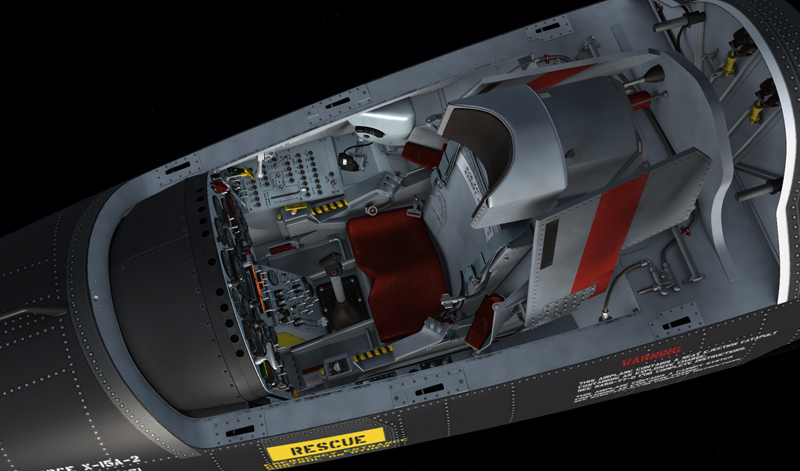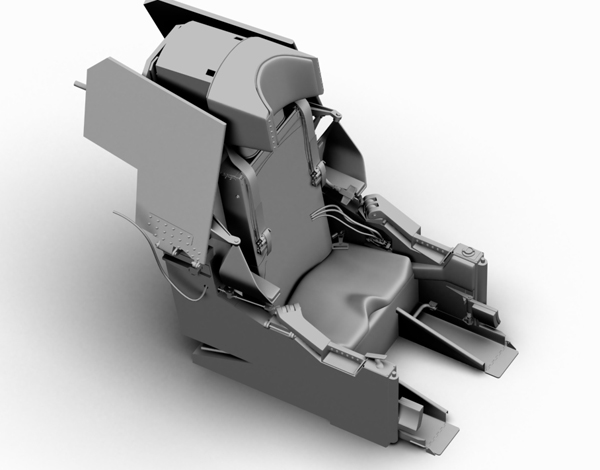
X-15A-2 SE ejection seat (virtual cockpit screenshot, canopy removed).
On the real aircraft, the ejection seat is designed to permit safe pilot ejection up to Mach 4.0, in any attitude, and at any altitude up to 120,000 feet.
Firing of the seat is initiated by jettisoning the canopy. The seat cannot be ejected unless the canopy has left the airplane.
Note: The ejection seat on the X-15A-2 addon is highly detailed and has some animated features (see below). However, it cannot eject from the cockpit in this software version. Animating and programming the complex ejection method used on the X-15 airplane, including modeling the parachutes, was beyond the scope of this project.
A ballistic-rocket type catapult supplies the necessary propulsion force to eject the seat and pilot from the airplane. During ejection, stabilizing fins [8, fig. 4-2] and booms automatically extend to stabilize the seat. Restraint devices [5, 9, 10, 15, 17, fig. 4-2] are provided for the pilot's body and legs to prevent injuries and separation from the seat above 15,000 feet. At this altitude, an aneroid device fires three initiators to free the restraint devices and permit pilot separation from the seat. A manual handle is provided to permit the pilot to release the restraints if the aneroid device fails. If ejection below 15,000 feet is accomplished, there is a 3-second delay after ejection before automatic pilot-seat separation is initiated.
The breathing oxygen supply is contained in cylinders mounted to the underside of the seat [4, fig. 4-2] and is used when the airplane is launched from the carrier airplane. While in captive flight, breathing oxygen is supplied by the carrier airplane. An oxygen selector valve and gauge [18, fig. 4-2] on the left side of the seat permits selection of either carrier airplane oxygen or the seat-contained oxygen.
The personal leads [12, fig. 4-2] (radio, oxygen, and ventilated suit) are attached to a disconnect block that is fitted into a disconnect fitting on the left side inside the seat bucket. The ejection seat also has a quick-disconnect receptacle [12, fig. 4-2] to plug in the pilot's physiological instrumentation wiring harness. The receptacle is on the top of the seat pan in the forward right-hand corner.
The manually adjustable shoulder harness straps [5, fig. 4-2] are fastened to the integrated parachute restraint harness with quick-disconnect fittings. During the ejection sequence, the shoulder harness is released when the headrest [1, fig. 4-2] ejects. The pilot's parachute is carried in a container [3, fig. 4-2] attached to the pilot's integrated harness, with a pilot chute in a separate container [2, fig. 4-2]; the pilot chute is released when the headrest is ejected. The operation sequence of the aneroid device is actuated at 15,000 feet, and it fires the three initiators that fire the headrest and release the seat belt, personal leads, ejection handles, and all restraints, to permit pilot separation from the seat.
This red handle, flush-mounted on the right side of the fuselage, contains a cutter mechanism that is an integral part of the handle. The seat initiator hose is routed through a slotted spindle, which actually is the pivot point of the handle. When the handle is pulled outward, a sleeve rotates on the spindle to force the sharp edges of the slot against the hose. As the hose is cut, the cutter acts as a block that prevent the passage of expanded gasses that could otherwise make their way to the seat catapult if the loose hose ends were aligned. In its stowed position, the handle is secure at the lower end by a quick-acting fastener that can be released with counterclockwise turn of a screwdriver.
On the real aircraft, unlatching and raising either ejection handle on the seat [10, fig. 4-2] to within 15 degrees of its full travel fires an initiator that fires the canopy remover. As the canopy leaves the airplane, it fires the seat catapult initiator that fires the two-stage seat catapult.
The ejection handle release latch is in the top portion of each ejection handle and is actuated when either ejection handle is grasped. Since the ejection handle assemblies are linked together by a linkage to a torque tube, pulling up on either ejection handle automatically raises the other. The ejection handles lock in the full travel position until unlocked by the restraint release system. If the canopy is inadvertently lost in flight, the seat will not eject unless the ejection handles are raised. During pilot separation from the seat after ejection, the ejection handle assemblies are automatically unlocked and swing out board to permit unrestricted pilot separation from the seat.
Modified ejection seats and pressure suits provide automatic actuation of the pilot's emergency oxygen supply when the ejection handles are raised. As the handles are raised, a cable pulls the pin from the emergency oxygen supply valve. The cable is attached in parallel with the manual actuation cable.
Note: Clicking either ejection handle in the virtual cockpit with the mouse will make them travel up or down. The ejection handles are not animated on the exterior model. The canopy and the seat cannot be ejected in this software version (see above).

The X-15 ejection seat (original 3D model).
On the real aircraft, a restraint emergency release handle [13, fig. 4-2], on the right side of the ejection seat, is pulled up to afford a quick release from the seat on the ground when the manual release would be too slow, or after ejection if the aneroid device fails to actuate the automatic restraint release system. Pulling this handle releases the foot restraints [15, fig. 4-2], lap belt [11, fig. 4-2], personal leads [12, fig. 4-2], and armrest assemblies [9, fig. 4-2], and fires the headrest [1, fig. 4-2] which releases the shoulder harness [5, fig. 4-2].
Note: Pulling (dragging with the mouse) this yellow handle in the virtual cockpit will release the foot restraints and move the ejection handles [10, fig. 4-2] to their normal position.
The foot restraint release buttons [14, fig. 4-2] are on the top front corners of the seat, above each foot restraint [15, fig. 4-2]. Depressing each button unlocks its respective foot restraint, which releases the pilot's feet. During automatic pilot-seat separation, the foot restraints unlock automatically.
Note: Clicking either yellow foot restraint release button in the virtual cockpit will release or lock the foot restraints.
Refer to "Safety Pins" under "Canopy".
See also:
Parachute, Integrated Restraint Equipment and Pressure Suit